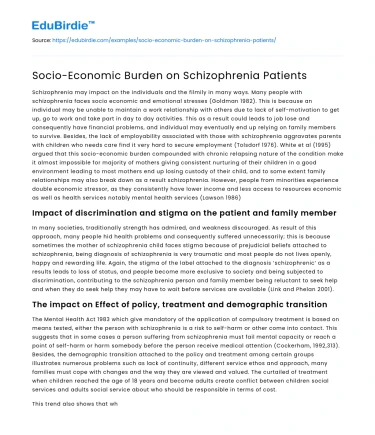Schizophrenia may impact on the individuals and the filmily in many ways. Many people with schizophrenia faces socio economic and emotional stresses (Goldman 1982). This is because an individual may be unable to maintain a work relationship with others due to lack of self-motivation to get up, go to work and take part in day to day activities. This as a result could leads to job lose and consequently have financial problems, and individual may eventually end up relying on family members to survive. Besides, the lack of employability associated with those with schizophrenia aggravates parents with children who needs care find it very hard to secure employment (Tolsdorf 1976). White et al (1995) argued that this socio-economic burden compounded with chronic relapsing nature of the condition make it almost impossible for majority of mothers giving consistent nurturing of their children in a good environment leading to most mothers end up losing custody of their child, and to some extent family relationships may also break down as a result schizophrenia. However, people from minorities experience double economic stressor, as they consistently have lower income and less access to resources economic as well as health services notably mental health services (Lawson 1986)
Impact of discrimination and stigma on the patient and family member
In many societies, traditionally strength has admired, and weakness discouraged. As result of this approach, many people hid health problems and consequently suffered unnecessarily; this is because sometimes the mother of schizophrenia child faces stigma because of prejudicial beliefs attached to schizophrenia, being diagnosis of schizophrenia is very traumatic and most people do not lives openly, happy and rewarding life. Again, the stigma of the label attached to the diagnosis ‘schizophrenic’ as a results leads to loss of status, and people become more exclusive to society and being subjected to discrimination, contributing to the schizophrenia person and family member being reluctant to seek help and when they do seek help they may have to wait before services are available (Link and Phelan 2001).
Save your time!
We can take care of your essay
- Proper editing and formatting
- Free revision, title page, and bibliography
- Flexible prices and money-back guarantee
The impact on Effect of policy, treatment and demographic transition
The Mental Health Act 1983 which give mandatory of the application of compulsory treatment is based on means tested, either the person with schizophrenia is a risk to self-harm or other come into contact. This suggests that in some cases a person suffering from schizophrenia must fail mental capacity or reach a point of self-harm or harm somebody before the person receive medical attention (Cockerham, 1992,313). Besides, the demographic transition attached to the policy and treatment among certain groups illustrates numerous problems such as lack of continuity, different service ethos and approach, many families must cope with changes and the way they are viewed and valued. The curtailed of treatment when children reached the age of 18 years and become adults create conflict between children social services and adults social service about who should be responsible in terms of cost.
This trend also shows that whenever there is delay of transition youth schizophrenia from community to hospital due to CAMHS shortage beds increase the level of risk among children and young people undergo. These risks may include self-harm, suicide, sexual and violent assault (Lewis et al 2005 and NICE NG43 2016). Burr et al. (1979); (Caton et al. (1999) and White et al. (1995) argued that, the demographic trends also shows high level of people with schizophrenia becoming parents and women leading the chased. However, miller and Finnerty (1996); Mowbray et al. 1995a, 1995b; White et al. (1995) strongly argued that, women with schizophrenia are not just likely to become parents but also most of the pregnancies are unplanned consequently causing divorce and they are more likely to raise the children by themselves.
Although the transitional of schizophrenia inpatient health setting to community, care home, shelter accommodation or back to their family as way of deinstitutionalisation by the policy has had negative impact on those people using the services and their families. The main issues arising from this deinstitutionalisation are lack of integrated service and collaborative working practitioners. This has led to inadequate and break-up of support for service users leading to a pattern of discharge, relapse, readmission and so forth. (Goodwin 1997). Further, the delays and timing of admission in transition of schizophrenia mental ill-patient from the community to the hospital due to shortage of inpatient beds, means that those vulnerable people cannot access services on time when they needed it most. This exacerbates the stress and depresses among the patients and their families endured, and to some extent leading to the unbearable burden on families (Gasby and Tew 2015).






 Stuck on your essay?
Stuck on your essay?

